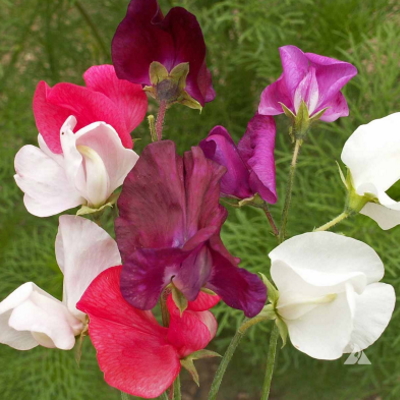-
Out of stock
 Growing on an upright bush, bright yellow, stringless pods of 10-15 cm are easy to spot among green foliage. Delicious buttery flavour. When planted in full sun they are prolific producers reaching a height of 37-50 cm tall and spread 37-50 cm.
Growing on an upright bush, bright yellow, stringless pods of 10-15 cm are easy to spot among green foliage. Delicious buttery flavour. When planted in full sun they are prolific producers reaching a height of 37-50 cm tall and spread 37-50 cm. -
Out of stock
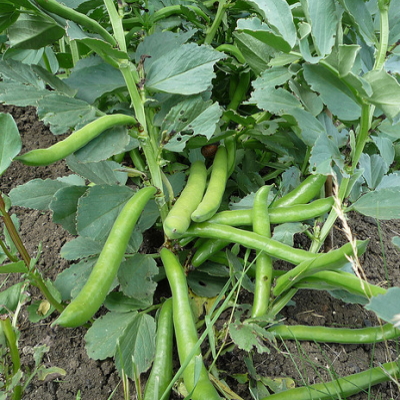 The best bean to try in 2021. Unlike most beans, fava beans prefer cool weather and are best planted in early spring as soon as the soil can be worked. Sow 2.5 cm deep, 10-12 cm apart, in rows 40-90 cm apart or use wide-bed style planting, giving each plant 25 sq.cm of space. Vroma produces large, 15-18 cm pods with 4–5 large seeds. Cook like a shell bean when the seeds are pale green or wait until pods are dry for shelled beans. Strong, heat-tolerant plants resist lodging. Light brown seeds. These lovely plants reach 1-1.5 M high and are self-supporting.
The best bean to try in 2021. Unlike most beans, fava beans prefer cool weather and are best planted in early spring as soon as the soil can be worked. Sow 2.5 cm deep, 10-12 cm apart, in rows 40-90 cm apart or use wide-bed style planting, giving each plant 25 sq.cm of space. Vroma produces large, 15-18 cm pods with 4–5 large seeds. Cook like a shell bean when the seeds are pale green or wait until pods are dry for shelled beans. Strong, heat-tolerant plants resist lodging. Light brown seeds. These lovely plants reach 1-1.5 M high and are self-supporting. -
Out of stock
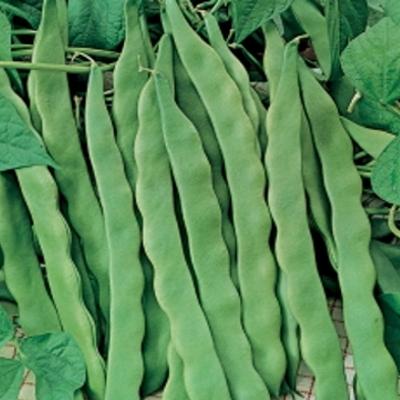 Admires bean is a dwarf, medium early variety that produces stringless, green, broad pods reaching 15 cm in length. They strike with their excellent taste and tenderness. White seeds that contain large amounts of proteins, carbohydrates, and B vitamins are hidden within the pods. The best European bush slicing bean! Superior in taste and yields. Produces flat beans which are 15 cm long and 2.5 cm wide. This is an early healthy variety.
Admires bean is a dwarf, medium early variety that produces stringless, green, broad pods reaching 15 cm in length. They strike with their excellent taste and tenderness. White seeds that contain large amounts of proteins, carbohydrates, and B vitamins are hidden within the pods. The best European bush slicing bean! Superior in taste and yields. Produces flat beans which are 15 cm long and 2.5 cm wide. This is an early healthy variety. -
Out of stock
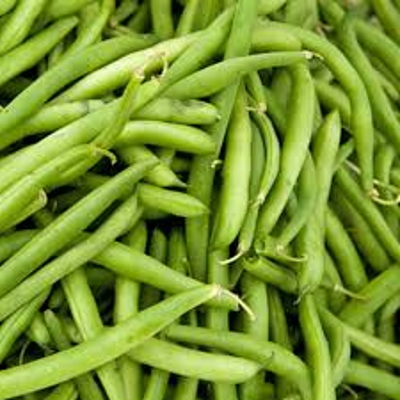 The tendergreen variety of bean produces abundant yields of 12-18 cm pods. Tendergreens are resistant to common bean mosaic. This is a bush type bean plant, so it can grow independent of a pole or support. This plant is best suited for a more advanced gardener, as the window for harvesting is rather short, about two weeks. It is beneficial to sow a few different plants about ten days apart. These plants pay off well, with tender and delicious green pods with a mild and delicious taste. This is a great main crop variety for gardeners who enjoy freezing and canning.
The tendergreen variety of bean produces abundant yields of 12-18 cm pods. Tendergreens are resistant to common bean mosaic. This is a bush type bean plant, so it can grow independent of a pole or support. This plant is best suited for a more advanced gardener, as the window for harvesting is rather short, about two weeks. It is beneficial to sow a few different plants about ten days apart. These plants pay off well, with tender and delicious green pods with a mild and delicious taste. This is a great main crop variety for gardeners who enjoy freezing and canning. -
Out of stock
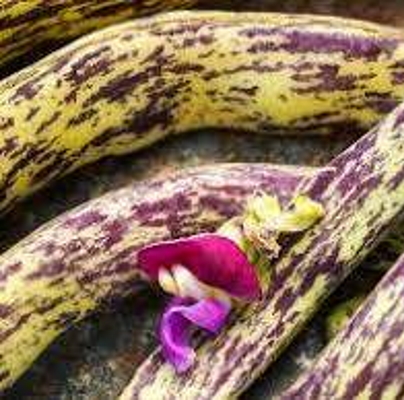 For bean lovers everywhere, this wax bush bean has an outstanding flavour, although we found that they take a bit longer to cook than other fresh beans, they quickly became a favourite. This charming wax bush bean is an old heirloom from Europe. It has yellow-green pods that are streaked and mottled with a gorgeous purple. Plants grow to be between 60-75 cm tall in a bush growth habit. The flavour of the pods is excellent and a must-try! This bean can be harvested as a green bean when pods are crisp or left to mature further and harvested as a shelling bean. The seeds are a mottled brown and very tasty. These pods are versatile both in their use, and their unique colouring. They can be used either fresh or as dried beans, and there is no other variety with coloring quite like theirs.
For bean lovers everywhere, this wax bush bean has an outstanding flavour, although we found that they take a bit longer to cook than other fresh beans, they quickly became a favourite. This charming wax bush bean is an old heirloom from Europe. It has yellow-green pods that are streaked and mottled with a gorgeous purple. Plants grow to be between 60-75 cm tall in a bush growth habit. The flavour of the pods is excellent and a must-try! This bean can be harvested as a green bean when pods are crisp or left to mature further and harvested as a shelling bean. The seeds are a mottled brown and very tasty. These pods are versatile both in their use, and their unique colouring. They can be used either fresh or as dried beans, and there is no other variety with coloring quite like theirs. -
Out of stock
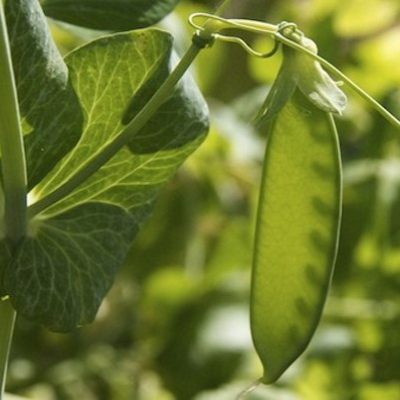 Certified Organic. Sweet peas inside big, sweet pods combine for a delicious flavor treat. High yields of large, medium-green, flat pods follow white-flowered vines. High resistance to Fusarium wilt race 1, pea enation mosaic virus, and powdery mildew. Eat fresh, add to salads or use in a stir fry.
Certified Organic. Sweet peas inside big, sweet pods combine for a delicious flavor treat. High yields of large, medium-green, flat pods follow white-flowered vines. High resistance to Fusarium wilt race 1, pea enation mosaic virus, and powdery mildew. Eat fresh, add to salads or use in a stir fry. -
Out of stock
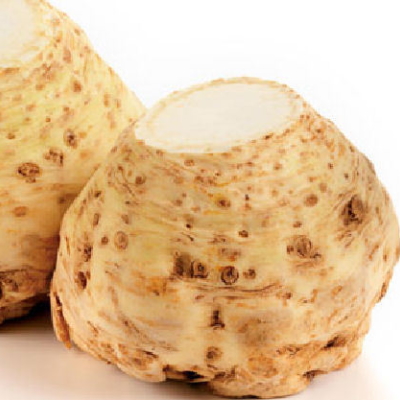 Improved Giant Prague variety. The giant root is excellent for stews and soups. Start 8-12 weeks indoors.
Improved Giant Prague variety. The giant root is excellent for stews and soups. Start 8-12 weeks indoors. -
Out of stock
 Salsify is popular in Europe. This root vegetable is eaten grated or cooked. As a relative to the lettuce family, tt has grass-like foliage and purple flowers in the second year. The foliage and flowers are edible and the roots can be left in the ground until needed. It is also known as Oyster vegetable. In soils which freeze cover with a thick layer of straw and a row tunnel to harvest during winter months.
Salsify is popular in Europe. This root vegetable is eaten grated or cooked. As a relative to the lettuce family, tt has grass-like foliage and purple flowers in the second year. The foliage and flowers are edible and the roots can be left in the ground until needed. It is also known as Oyster vegetable. In soils which freeze cover with a thick layer of straw and a row tunnel to harvest during winter months. -
Out of stock
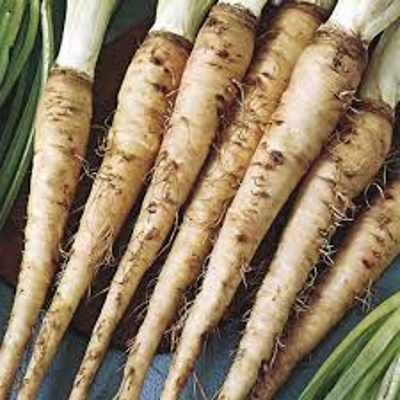 Roots are long and tapered like carrots, with off-white skin and white flesh. The upright, grass-like leaves and edible, second-summer purple flowers distinguish it from scorzonera. An excellent storage root, salsify can also be overwintered for spring harvest, like with parsnips. This is a biennial vegetable which averages 20-25 cm long and 2.5 cm round.
Roots are long and tapered like carrots, with off-white skin and white flesh. The upright, grass-like leaves and edible, second-summer purple flowers distinguish it from scorzonera. An excellent storage root, salsify can also be overwintered for spring harvest, like with parsnips. This is a biennial vegetable which averages 20-25 cm long and 2.5 cm round. -
Out of stock
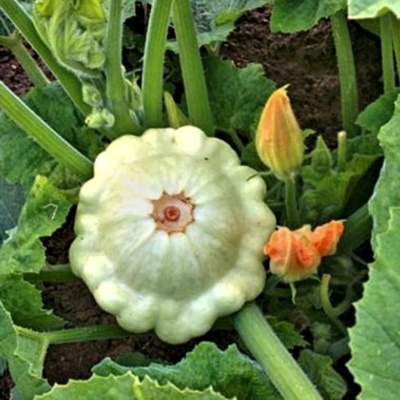 Early (45-55 days) open-pollinated variety. Young squashes are pale green, tender turning to white, strong and crunchy when ripen. Each stage has its own taste with a delicious nutty flavor. Use young, delicate, very sweet squashes up to 7.5cm (3in.) for roasting, grilling, and pickling. When 12-15cm they are great for toppings and soups with a zucchini-like texture. Double culture for summer use and long-term (winter) storage.
Early (45-55 days) open-pollinated variety. Young squashes are pale green, tender turning to white, strong and crunchy when ripen. Each stage has its own taste with a delicious nutty flavor. Use young, delicate, very sweet squashes up to 7.5cm (3in.) for roasting, grilling, and pickling. When 12-15cm they are great for toppings and soups with a zucchini-like texture. Double culture for summer use and long-term (winter) storage. -
Out of stock
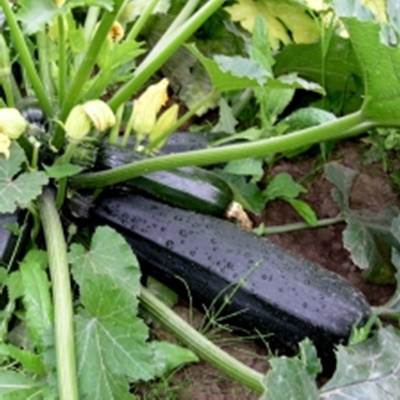 Matures in 60 days. The standard summer squash was introduced in the 1920s. Plants are productive very early and produce until feeze-up if kept picked. Best eaten when under 20cm. Black Beauty zucchini seeds are a great variety for freezing. Black Beauty zucchini is a 20th Century heirloom that won the All-American Selections prize back in 1957. It was first introduced to American market growers in the 1920s. Direct sow or transplant in late May or early June when the soil is warm. For transplants, start seeds indoors in late April or early May. Optimal soil temperature for germination: 25-35°C. Seeds should sprout in 7-14 days.
Matures in 60 days. The standard summer squash was introduced in the 1920s. Plants are productive very early and produce until feeze-up if kept picked. Best eaten when under 20cm. Black Beauty zucchini seeds are a great variety for freezing. Black Beauty zucchini is a 20th Century heirloom that won the All-American Selections prize back in 1957. It was first introduced to American market growers in the 1920s. Direct sow or transplant in late May or early June when the soil is warm. For transplants, start seeds indoors in late April or early May. Optimal soil temperature for germination: 25-35°C. Seeds should sprout in 7-14 days. -
Out of stock
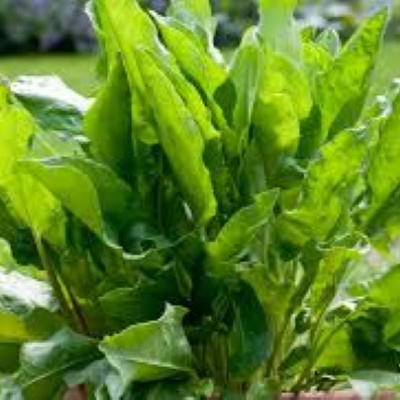 Rumex acetosa) 35 days (baby), 50 days (mature) - Perennial in zones 4-9. French Lemon Sorrel is a must-have for no-hassle gardeners. Able to establish itself as a perennial in a wide range of Canada Sorrel is one of the earliest and latest greens in your garden coming up on its own at the beginning of spring. Each tender leaf is up to eight inches long and has a delicious lemon flavour. This is a great all-around open-pollinated sorrel variety, adaptable to any home organic vegetable garden.
Rumex acetosa) 35 days (baby), 50 days (mature) - Perennial in zones 4-9. French Lemon Sorrel is a must-have for no-hassle gardeners. Able to establish itself as a perennial in a wide range of Canada Sorrel is one of the earliest and latest greens in your garden coming up on its own at the beginning of spring. Each tender leaf is up to eight inches long and has a delicious lemon flavour. This is a great all-around open-pollinated sorrel variety, adaptable to any home organic vegetable garden. -
Out of stock
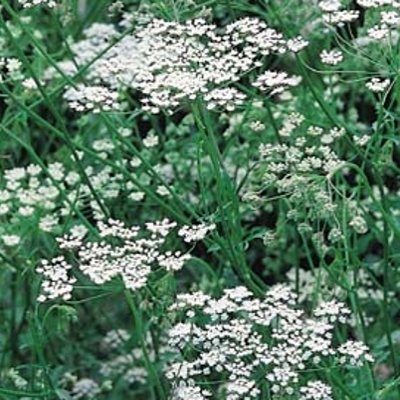 Anise is always grown in our gardens, they not only have attractive foliage but their seeds are harvested in our kitchens for soups, spreads, salad dressings, cakes, and cookies. Seeds and leaves carry a sweet, licorice-like flavor, make a comforting tea, or a tasty breath freshener. Many use Anise as a treatment for sore throats, indigestion, and flatulence. Anise essential oil is used to flavor licorice candy. Try the feathery leaves fresh in salads and soups. Umbrella-like clusters of tiny white flowers bloom in July, attract butterflies, bees, and beneficial insects. Seed heads attract birds.
Anise is always grown in our gardens, they not only have attractive foliage but their seeds are harvested in our kitchens for soups, spreads, salad dressings, cakes, and cookies. Seeds and leaves carry a sweet, licorice-like flavor, make a comforting tea, or a tasty breath freshener. Many use Anise as a treatment for sore throats, indigestion, and flatulence. Anise essential oil is used to flavor licorice candy. Try the feathery leaves fresh in salads and soups. Umbrella-like clusters of tiny white flowers bloom in July, attract butterflies, bees, and beneficial insects. Seed heads attract birds. -
Out of stock
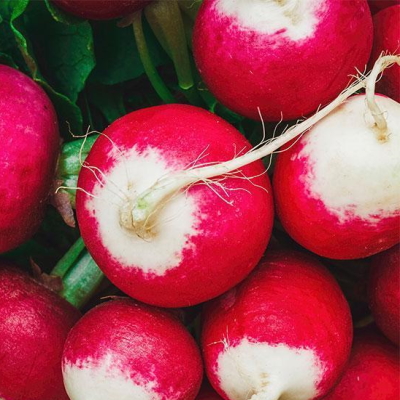 Heirloom Sparkler Radish Seeds. This fast cool-season crop is a delight with its pretty red skin that changes to white at the tip. Matures in 25 to 30 days. The bright but mild radish flavor is a crowd-pleaser and at 2.5-4 cm is great on a relish tray or eating out of hand.
Heirloom Sparkler Radish Seeds. This fast cool-season crop is a delight with its pretty red skin that changes to white at the tip. Matures in 25 to 30 days. The bright but mild radish flavor is a crowd-pleaser and at 2.5-4 cm is great on a relish tray or eating out of hand. -
Out of stock
 French Breakfast radish is known for its vibrant coloring which graduates from a vivid fuchsia-red to bright white at the tip. Topped with edible, leafy greens, French Breakfast radishes are very crisp and offer a mildly spicy flavor. French Breakfast is a very fast growing variety, with radishes ready for harvest within a month.
French Breakfast radish is known for its vibrant coloring which graduates from a vivid fuchsia-red to bright white at the tip. Topped with edible, leafy greens, French Breakfast radishes are very crisp and offer a mildly spicy flavor. French Breakfast is a very fast growing variety, with radishes ready for harvest within a month. -
 Etournella Mix Sweet William is a Dianthus barbatus that produces an excellent bedding plant that makes an exceptional cut flower. Growing 45 cm high this Sweet William blooms earlier than other varieties. Perennial to zone 3 and has vivid colours in burgundy, pinks, rose and white and self-seeds. Cut spent flowers to promote more blossoms.
Etournella Mix Sweet William is a Dianthus barbatus that produces an excellent bedding plant that makes an exceptional cut flower. Growing 45 cm high this Sweet William blooms earlier than other varieties. Perennial to zone 3 and has vivid colours in burgundy, pinks, rose and white and self-seeds. Cut spent flowers to promote more blossoms. -
Out of stock
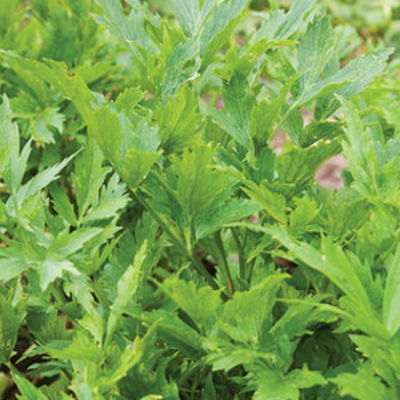
Specialty culinary herb. Young leaves taste like celery and are used in spring salads and with potato, rice, and poultry dishes. Roots and young stems are also edible. Young stems can be cut, peeled, and used in salads. Stems are smooth, hollow, and thick. Attracts Beneficial Insects: If allowed to flower, provides pollen and nectar for beneficial insects such as bees, hoverflies, lacewing larva, lady beetles, parasitic wasps, and tachinid flies.
-

Clematis-flowered columbine. Fluffy, star-shaped blooms with pointed, overlapping petals resemble petite clematis flowers. Fully double 3-4 cm upward-facing and nodding, spurless flowers. Blooms late spring of the second year from a spring sowing. An excellent cut flower, it has strong, straight stems and fills the gap between early spring and summer bouquets. Produces multiple blooms per stem. The mix includes Victorian shades in a complementary color palette: rose, almost black, violet, deep wine red, dark purple, white, and purple-edged white. Attracts hummingbirds.
-
Out of stock
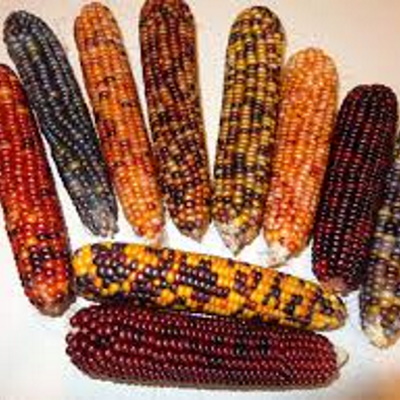 Small kernels on 15 cm, multi-coloured cobs in yellow, brown, white, purple, red, and blue. Use Calico Popcorn seeds for edible popping corn, or simply as ornaments to mark the harvest season in early fall. Give the tall, slow-growing plants as early a start as possible for the ripest cobs. Expect mixed colours on every stalk. This is not a sweet corn variety and is not intended for eating as corn on the cob. But the kernels really do pop once they have fully dried.
Small kernels on 15 cm, multi-coloured cobs in yellow, brown, white, purple, red, and blue. Use Calico Popcorn seeds for edible popping corn, or simply as ornaments to mark the harvest season in early fall. Give the tall, slow-growing plants as early a start as possible for the ripest cobs. Expect mixed colours on every stalk. This is not a sweet corn variety and is not intended for eating as corn on the cob. But the kernels really do pop once they have fully dried. -
Out of stock
 Cylindra Beets produce long, dark red roots. The unique roots look similar to carrots and provide more uniform slices than round beet varieties. The roots are great when used fresh, diced, canned, pickled, or frozen while the tops are great for salads. Try planting a few using our group planting method in TIP
Cylindra Beets produce long, dark red roots. The unique roots look similar to carrots and provide more uniform slices than round beet varieties. The roots are great when used fresh, diced, canned, pickled, or frozen while the tops are great for salads. Try planting a few using our group planting method in TIP -
Out of stock
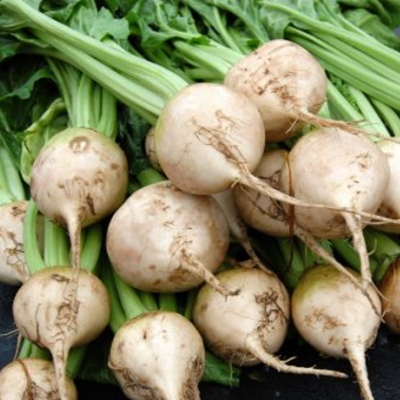
Mild and sweet white beet. Produces very round, uniform roots to harvest as a baby beet or as a mature beet. Avalanche produces mild, very sweet beets with nice white colour both on skin and flesh. Avalanche lacks the reddish skin and bitter aftertaste that other beets possess. Healthy tops have good resistance to foliar diseases. Avalanche produces consistently large, round roots with clean, vigorous tops. A great beet for daily juicing. Try juicing the whole beet it with broccoli, carrots, and apple. Very slow to go woody. 50 days to harvest at 8 cm roots. Try planting a few using our group planting method in TIP
-
 Use seeds, leaves, and flowers. Bright, sunny colors: yellow, pink, red, and orange. The edible flowers are popular for salads and as a garnish; the peppery leaves are also very flavorful. A colourful garden favorite. Flowers all summer long. Keep watered during dry weather, and do not fertilize. Excellent in window boxes, hanging baskets, or raised beds. Suitable for xeriscaping
Use seeds, leaves, and flowers. Bright, sunny colors: yellow, pink, red, and orange. The edible flowers are popular for salads and as a garnish; the peppery leaves are also very flavorful. A colourful garden favorite. Flowers all summer long. Keep watered during dry weather, and do not fertilize. Excellent in window boxes, hanging baskets, or raised beds. Suitable for xeriscaping -
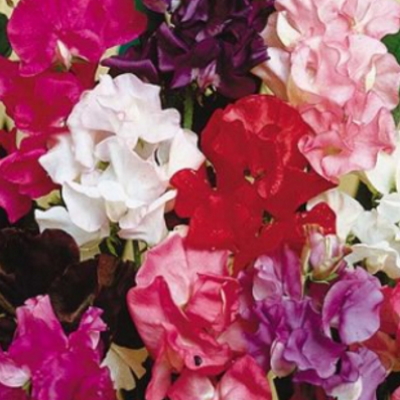 One of the best extra large flowers in a blend of deep rose, salmon, cream, pink, scarlet, white, mid blue, and crimson. Sow Mammoth Blend sweet pea seeds for the earliest sweet peas to bloom from late spring to early summer. Direct sow sweet pea seeds at three-week intervals for an extended bloom period. They have very large flowers on long stems, so they're a great cut flower. Their scent is more subdued than other sweet pea varieties.
One of the best extra large flowers in a blend of deep rose, salmon, cream, pink, scarlet, white, mid blue, and crimson. Sow Mammoth Blend sweet pea seeds for the earliest sweet peas to bloom from late spring to early summer. Direct sow sweet pea seeds at three-week intervals for an extended bloom period. They have very large flowers on long stems, so they're a great cut flower. Their scent is more subdued than other sweet pea varieties. -
 Double flowers with a silky appearance in shades of pink, white, red, rose, and salmon on 80 cm stems. Strong plants perform well in the heat and drought even though they are considered a cool-season plant. Sow Shirley Double Mix poppy seeds at two-week intervals from late February to mid-April for flowers from mid- to late summer. These poppies will self-sow, and they look spectacular in mass plantings. The flowers have a very delicate appearance, but the plants are actually quite tough. For cut flowers use a candle to sear the stem ends to help them last several days. Rely on Shirley Double to self-sow without becoming weedy.
Double flowers with a silky appearance in shades of pink, white, red, rose, and salmon on 80 cm stems. Strong plants perform well in the heat and drought even though they are considered a cool-season plant. Sow Shirley Double Mix poppy seeds at two-week intervals from late February to mid-April for flowers from mid- to late summer. These poppies will self-sow, and they look spectacular in mass plantings. The flowers have a very delicate appearance, but the plants are actually quite tough. For cut flowers use a candle to sear the stem ends to help them last several days. Rely on Shirley Double to self-sow without becoming weedy. -
-
 Bridal Silk is a Shirley poppy. Shirley poppies thrive in cool temperatures and must be sown when the soil is still cold. 'Bridal Silk' has glistening pure-white chalice-shaped flowers in glorious bloom during early summer, new flowers opening every morning as the old flowers shed their petals. These plants prefer evenly moist soil but can tolerate drought. About an inch of water per week is more than sufficient once they are established. Plant height 45-60 cm.
Bridal Silk is a Shirley poppy. Shirley poppies thrive in cool temperatures and must be sown when the soil is still cold. 'Bridal Silk' has glistening pure-white chalice-shaped flowers in glorious bloom during early summer, new flowers opening every morning as the old flowers shed their petals. These plants prefer evenly moist soil but can tolerate drought. About an inch of water per week is more than sufficient once they are established. Plant height 45-60 cm. -
Out of stock
 Also known as mountain spinach, this green has been cultivated since Roman times. Harvest young leaves 3-7 cm long for fresh use. Larger leaves are often used steamed. A colorful and nutritious addition to salads. Leaves can continue to be harvested until the plant goes to seed. Can be grown into summer somewhat longer than true spinach. Germinated in 7-14 days. Maturity from 20 to 60 days.
Also known as mountain spinach, this green has been cultivated since Roman times. Harvest young leaves 3-7 cm long for fresh use. Larger leaves are often used steamed. A colorful and nutritious addition to salads. Leaves can continue to be harvested until the plant goes to seed. Can be grown into summer somewhat longer than true spinach. Germinated in 7-14 days. Maturity from 20 to 60 days. -
Out of stock
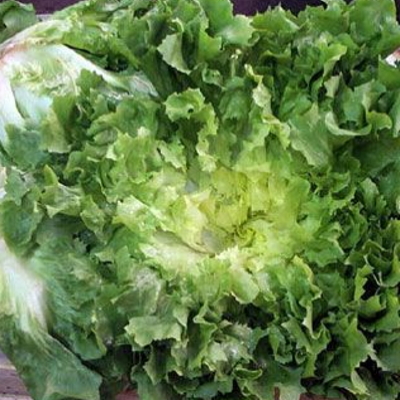 This escarole type of endive has dark green leaves that are broad, coarse and crumpled in appearance but not curly. Popular as an addition to any salad or may be cooked as greens. Harvest as you would lettuce by cutting them just below the lower leaves. They will withstand a touch of frost but not a hard freeze.
This escarole type of endive has dark green leaves that are broad, coarse and crumpled in appearance but not curly. Popular as an addition to any salad or may be cooked as greens. Harvest as you would lettuce by cutting them just below the lower leaves. They will withstand a touch of frost but not a hard freeze. -
Out of stock
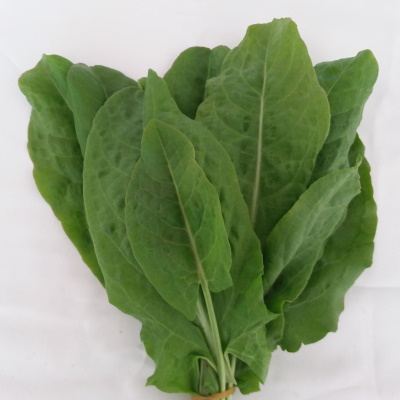
The herbal lemony flavor of sorrel makes a great addition to salads, sauces, or soups. A famed companion to fish. Will produce the most tender leaves in cool weather. Sow in spring or fall. Once established, can be propagated by root division. Hardy in zone 4-8. Perennial.
-
Out of stock

A stellar bulbing Florence fennel with an excellent sweet anise-like flavor that mellows with cooking. Selma Fino is usually the sweetest tasting. Takes about 80 days to form full-sized bulbs, however, it can be harvested sooner at a smaller size. Very white bulbs are fairly uniform and won’t prematurely bolt if planted in spring. Tops can be used as a fresh herb, adding a mellow fennel flavor to dishes or salads. Unique compared to other bulb type fennel, some plants have a perennial nature. The flowers are highly attractive to bees and other beneficial insects. Fennel leaves, florets, and seeds can be used for culinary purposes as an herb.
-
Out of stock
 A much-loved heirloom cabbage with solidly tight, conical, folded heads 13-18cm in diameter, and 26-39cm tall. Planted individually, Early Jersey Wakefield cabbage seeds will form a plant up to 1m in diameter. This cabbage has smooth, thick green leaves that are perfect for coleslaw. They can be harvested in summer or overwintered, and they resist splitting in wet weather. Early Jersey Wakefield cabbage seeds were first grown in the U.S. by Francis Brill of Jersey City in 1840.
A much-loved heirloom cabbage with solidly tight, conical, folded heads 13-18cm in diameter, and 26-39cm tall. Planted individually, Early Jersey Wakefield cabbage seeds will form a plant up to 1m in diameter. This cabbage has smooth, thick green leaves that are perfect for coleslaw. They can be harvested in summer or overwintered, and they resist splitting in wet weather. Early Jersey Wakefield cabbage seeds were first grown in the U.S. by Francis Brill of Jersey City in 1840. -
-
Out of stock
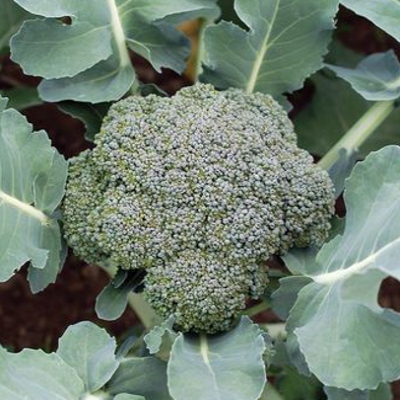 Blue Winds Broccoli is the most popular broccoli. This extra-early maturing broccoli produces impressively large, tightly beaded heads. The large plants are tightly beaded and sport powdery light blue foliage. They have strong-stems with densely packed heads. After harvesting of main head, Blue Winds Brocolli has good side shoot production will supply a continued harvest of delicious florets! One of the only hybrid crops we grow!
Blue Winds Broccoli is the most popular broccoli. This extra-early maturing broccoli produces impressively large, tightly beaded heads. The large plants are tightly beaded and sport powdery light blue foliage. They have strong-stems with densely packed heads. After harvesting of main head, Blue Winds Brocolli has good side shoot production will supply a continued harvest of delicious florets! One of the only hybrid crops we grow! -
Out of stock
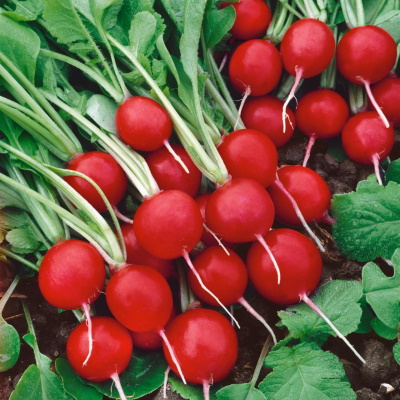
Early, organic, round red radish.
Try leaving some to grow seed pods which are delicious in salads or save your seeds for future plantings. Radishes thrive in very loose rich soil, plenty of water, and best grown in cooler weather.Roots are bright red, smooth, and uniform with good flavor. Best for spring and fall plantings. Crops sown in hot weather tend to produce roots that are less uniform and become pithy earlier than hybrids.
-
Out of stock
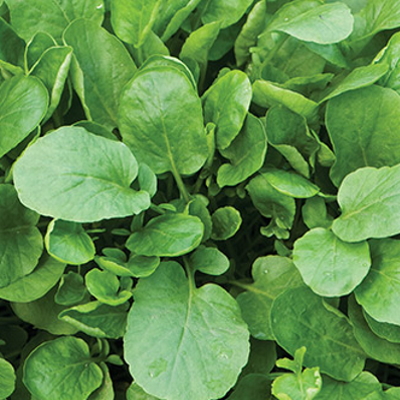
Upland Cress is slow to start but, once established, easy to grow. Long-standing and slow bolting. Harvest by cutting individual leaves or by picking the 15-18 cm rosettes of dark green, glossy, rounded leaves. Salad's come to life with the nutrient-packed upland cress leaves added. Cut the leaves when they are 2-5 cm tall. The leaves grow back in 2-3 weeks. Harvest as desired through the growing season.
Many common names of Barbarea verna are )Upland or Winter Cress), Early Yellow-rocket, Early Yellowrocket, Land Cress, Peppergrass, Upland Cress, Winter Cress -
Out of stock
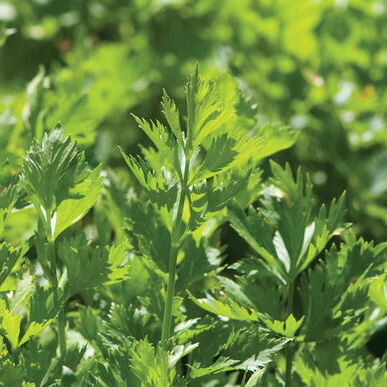
Leafy herb with bold celery flavor. Easier to grow than standard celery. A versatile ingredient for salads, soups, stews, and vegetable medleys. More intense flavour (both fresh and dried) than garden celery.
